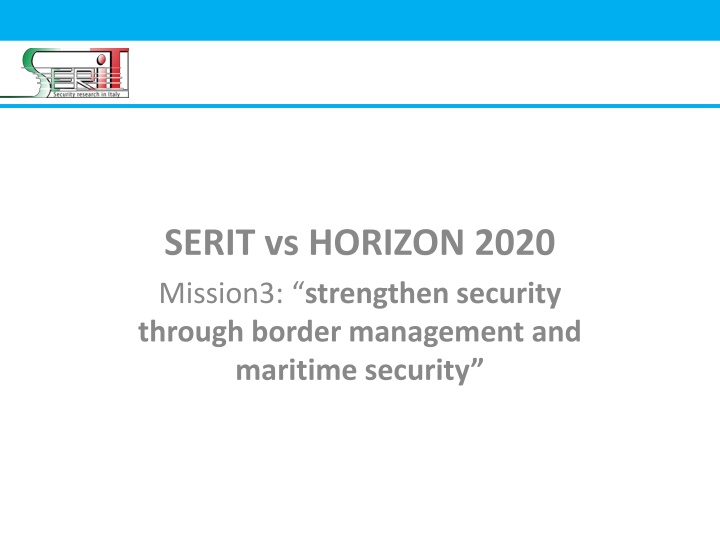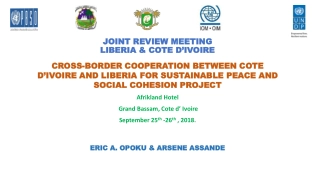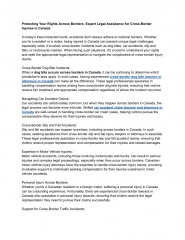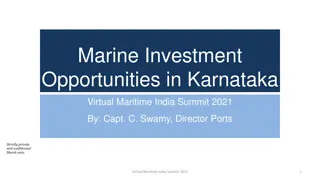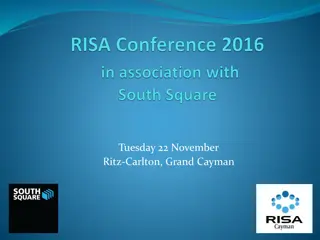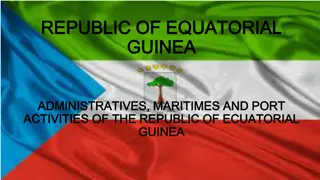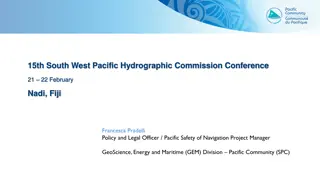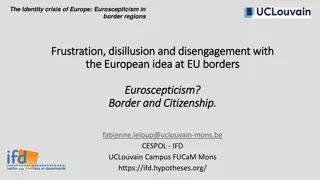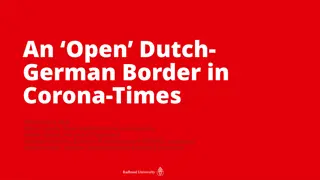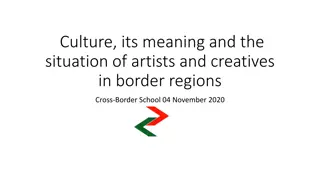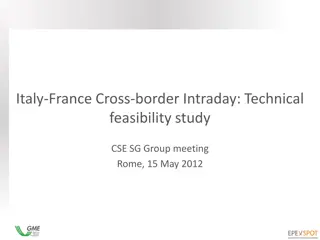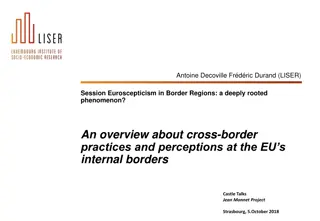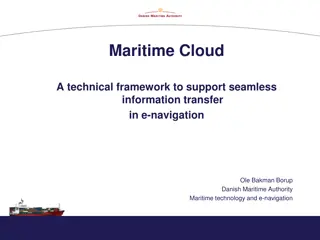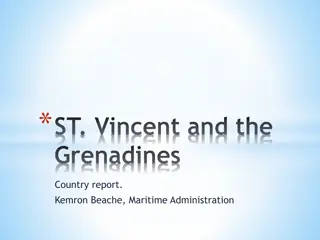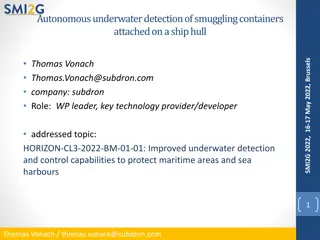Strengthen Security through Border Management and Maritime Security
Technologies and capabilities are required to enhance border security, including control and surveillance issues. Research aims to improve European border management through cooperation and development of advanced systems for rapid identification.
Download Presentation

Please find below an Image/Link to download the presentation.
The content on the website is provided AS IS for your information and personal use only. It may not be sold, licensed, or shared on other websites without obtaining consent from the author.If you encounter any issues during the download, it is possible that the publisher has removed the file from their server.
You are allowed to download the files provided on this website for personal or commercial use, subject to the condition that they are used lawfully. All files are the property of their respective owners.
The content on the website is provided AS IS for your information and personal use only. It may not be sold, licensed, or shared on other websites without obtaining consent from the author.
E N D
Presentation Transcript
SERIT vs HORIZON 2020 Mission3: strengthen security through border management and maritime security
Introduction Technologies and capabilities are also required to enhance systems, equipments, tools, processes, and methods for rapid identification to improve land, marine and coastal border security, including both control and surveillance issues, while exploiting the full potential of EUROSUR. These will be developed and tested considering their effectiveness, compliance with legal and ethical principles, proportionality, social acceptability and the respect of fundamental rights. Research will also support the improvement of the integrated European border management, including through increased cooperation with candidate, potential candidate and European Neighbourhood Policy countries. SERIT keywords: Perimetral Surveillance Systems, Detection and Imaging of People, Identification of Anomalous Events, Biometric Check-point, High Sensitivity Sensors for Trace Detection of Hazardous Components, Rapid Scanning Technologies, Data Fusion of Heterogenous Sensors, Ontologies, Interoperabilty, Multisensor intelligent platforms, Sensors for Maritime and/or Coastal Surveillance, Middleware, Networking Architecture and Communication, Multisensor Intelligent Platforms, Unmanned Systems
What we Need (1/3) BORDER CONTROL Enhance/improve the border check capabilities by means of new technologies (e.g. for multiple advanced biometrics, abnormal behaviour detection at multiple temporal scales, selective face recognition, multi-sensor analysis, identity management, intelligent information management) and novel approaches (e.g. automatic accreditation through smart biometric check points). New portable, miniaturized and interoperables tools and sensors with ICT interfaces should be developed for customs and borders in order to increase the speed and reliability of identification of unsafe foods, which can derive from accidental or intentional contamination. Being Airports a key nationwide access and exit points , they constitute a constellation of relevant border points at European/International level. The challenges coming from the mobility needs of citizens and the evolution of threats affecting the airport security, require an integrated approach. The development of an advanced system devoted to safety, security, dynamic risk management and passengers management shall then be encouraged and validated by all the stakeholders.
What we Need (2/3) BORDER SURVEILLANCE Italy, because of its central position in the Mediterranean Sea and its relevant coastal extension, aims at exploiting all the potentialities of an European Border Surveillance System and the forthcoming Common Information Sharing Environment. In the framework of EUROSUR guidelines, Italy is particularly interested in enhancing the capabilities of monitoring, detection, identification, tracking, prevention and interception of illegal border crossings as well as protecting and saving the lives of migrants and refugees. More advanced methodologies and techniques able to correlate different observations of the same target (from different systems, such as the evolutions foreseen for the Regional Traffic Monitoring Systems), need to be developed in order to increase and make more reliable the necessary Maritime Domain Awareness (as clearly established in the EU Integrated Maritime Policy Paper and in the recent Draft Roadmap for the Implementation of the EU CISE). This case evidences the condition for a dual- use research approach and the need for a strong collaboration between Civil and Military operators, that shall be then encouraged and sustained by proper funding frameworks (EFC - European Framework for Cooperation). Still on Maritime Surveillance, development of on-board sensors processing capability, data management, network servers (i.e. to generate automatically alerts regarding suspicious vessels over heavy traffic areas with numerous objects) should be further encouraged.
What we Need (3/3) CROSS-CUTTING ISSUES: INTEROPERABILTY Interoperability should be one of the objectives of further R&D activities for both border control and surveillance. Definition/adoption of European and worldwide standards (both at system and operating levels) should be encouraged and supported by technical solutions (e.g. Semantic Interoperability, Ontology Fusion, ), in order to involve and manage the cooperation among a large number of actors, while making available, correlating and exploiting huge global datasets (see also Big Data challenges), to achieve an integrated operational border management across boundaries.
Lighthouse Projects (1/2) Enhanced adaptive wide area surveillance & monitoring system, capable to facing various security issues (illegal migration of people, piracy, trafficking of drugs and weapons, as well as various natural disasters such as earthquake, flooding ) over large sea and land environments. New methods to improve border surveillance, taking into account crossing people and goods, are required, while achieving a full coverage of ground, air, sea, underwater and underground environment. Reinforcement of cooperation among involved operators and improving of the situational awareness by mean of a set of advanced technologies and components such as sensors (low cost radars, hyperspectral, active optronics, dust of sensors ), platforms (airships, UAV, UGV ), data fusion and big data management platforms. Initiatives to make the Airport infrastructure a comprehensive and fully integrated system for border checks through a wide security monitoring network with dynamic adaptation of security assets to the scenario changing, preserving the levels of performance and services for the public.
Lighthouse Projects (2/2) Regarding the maritime surveillance one or more lighthouse projects shall be launched to support the achievement of a maritime awareness tailored for specific civilian goals, developing suitable info-space environment as generated by putting together new surveillance capabilities/technologies and data sharing policies (e.g. CISE). Implementation of secure data transfer technology shall also allow the adaptation of military data for a civilian use, being compliant to privacy needs of the public and EU/National legal frameworks. A more specific example of project in the area of maritime domain could be generated by the main current limitations that prevent the full exploitation of Regional Vessel Traffic Monitoring Systems to have a real and reliable situational awareness. Overcoming these needs by the development of new technologies/solutions would lead to the definition of a totally new concept which can be synthesized as Public Regulated Regional Traffic Monitoring Service (borrowing the definition from other Services like the Galileo EU Navigation System). Use of unmanned platforms (such as Medium Altitude Long Endurance, MALE, and Unmanned Air-Vehicle System, UAS) for maritime and land surveillance, acting as the aerial node of a global network that integrates heterogeneous sensing technologies and will automatically generate alerts about suspicious events.
Roadmap Project Proposals: Horizon 2020 Keywords SERIT Technology References CSA/ CP / IP / DEMO / STREP Projects SERIT Keywords Timing rapid identification, marine and coastal border security, surveillance, border management, cooperation, EUROSUR, CISE Secure and Trusted Public Regulated Regional Traffic Monitoring Service sicurezza e dei confini, cooperazione, sorveglianza integrata TA1.2, TA1.6, TA1.8, TA1.10, TA5.1, TA5.6 IP medium term Sicurezza agroalimentare, dogane, porti, varchi transfrontalieri, sicurezza nei sistemi di logistica avanzata degli alimenti enhance systems, equipments, tools, processes, and methods for rapid identification, food security Realtime screening systems for contaminants in bulk food TA1.2, TA5.1, TA5.6, TA6.1, TA6.2, TA6.3, TA6.4, TA6.7 CP/IP medium term
